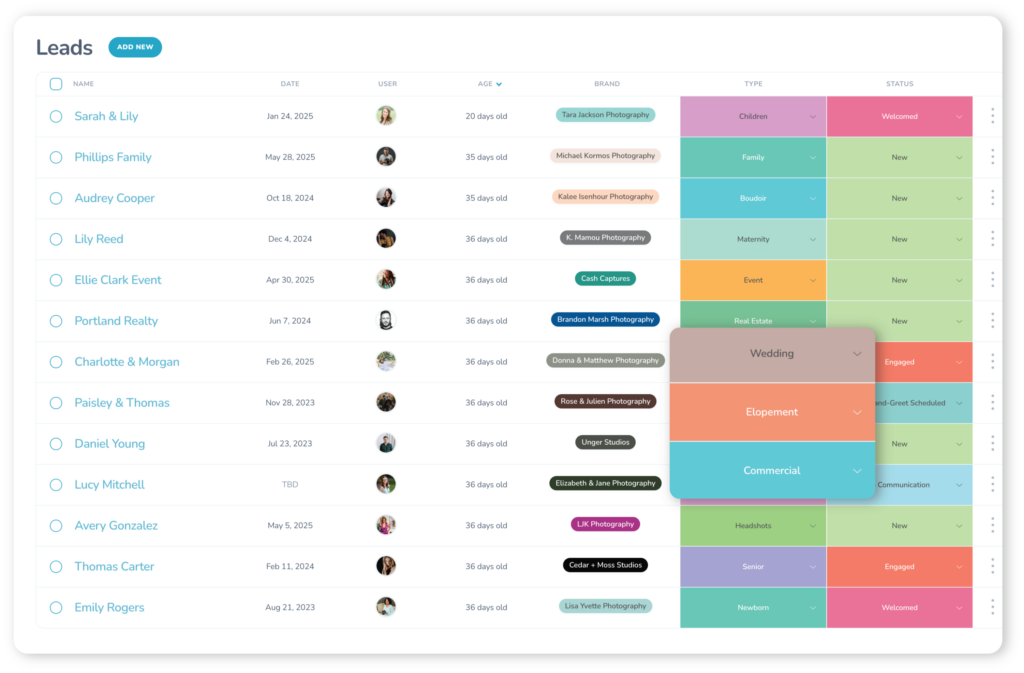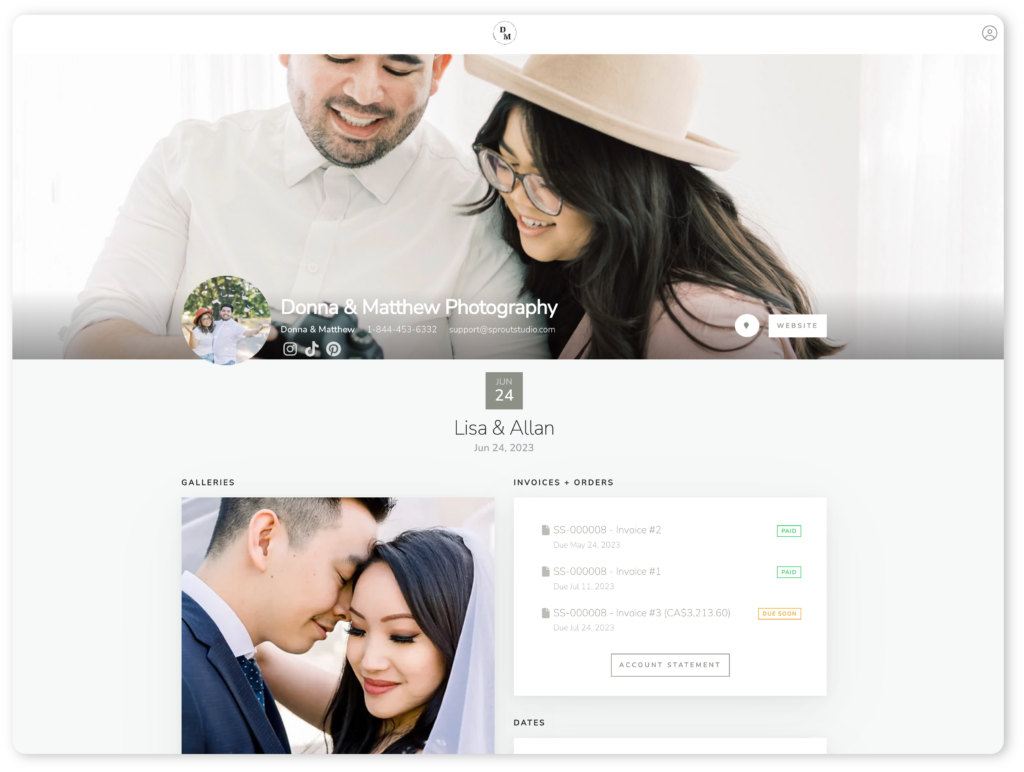There is much that can be learned by studying the successes of other businesses outside of our own photographic industry. One area in specific that we can observe is the art of “setting the scene” and how a great experience with a business often leads to greater sales and a more enjoyable process.
For instance, look at the dining experience at the Keg versus McDonalds, the buying experience at BMW versus Ford, or the support experience at the Apple Genius Bar versus your local computer repair shop. The first company in each comparison may indeed offer a better product or service, but it’s the refined experience that helps to justify their higher price point and increases the brand loyalty.

The goal of experience-based scene-setting is to stimulate all of the senses in a positive way. We want to create a sales environment that pleases our clients’ sight, smell, sound, taste and touch. We provide such an experience for three reasons:
- To create an environment where our clients can feel comfortable.
- To create such a positive experience that they would happily return to.
- To leave an impression that is remarkable and motivates them to share their experience with others.
The key to higher sales, greater affinity, deeper loyalty and increased referrals is experience-based scene-setting, and in this “how-to” article I will discuss some very specific ways that you can properly “set the scene” for a great sales experience.
First, let me re-enforce that it is crucial to be intentional about designing your customer experience, down to every little detail and that nothing can be overlooked. Your clients will notice everything, and as much as they’ll make mental notes about it all, they’ll also be internalizing much of it subconsciously without even realizing it, and this is why we must get real specific and obsessive about it.
Influencing the Five Senses
Here are some specific points for each of the five senses that you should consider when designing, setting-up or preparing your physical meeting space or studio for a client sales meeting, consult or appointment.
Touch
From the moment your client walks into your studio, every physical tactile interaction will be noted, and as such, every touch point is a reflection of you, your quality, and an indication of the experience the client can expect. The doorknob they turn, the feel of the flooring under their feet, the temperature of the room, the handshake that you greet them with, the furniture they sit on, the glass they drink from and the albums they flip through all will affect their impression.
Walk through your studio as a “new client” coming in for the first time. Observe every single physical element you come in contact with. Be sure that each touch-point leaves a consistent impression that is aligned with the brand you’re trying to project.
Sight
We are photographers after-all, and so all of the visuals in your studio will have an influence on your clients. We must pay close attention to the visual experience that our clients have with us in our studio. This can be broken down into 6 categories:
- The visual flow in your studio, which is the “visual path” a client takes when they enter the studio, as well as where their eyes are left to wander and settle on as they are sitting with you during the meeting. You need to be intentional about directing their vision to the right places, the right images, the right products and the right brand re-enforcers.
- The decor in your studio, which contributes to the feeling and mood of your space. This includes the colour of your walls, furniture, flooring, lighting, flowers, plants, and any other supplemental decor or visuals that add to the warmth of your studio.
- The wall portraits that you have displayed in your studio. Not only does proper sizing, grouping and placement have to be considered, but also the right presentation of the wall portraits – lighting, level, placement, height, and so on.
- The other products that you have on display which may include gift prints, books, albums, bags, totes, cards and so on. Again, care needs to be taken as to how they’re displayed, where they’re displayed and how they’re arranged in relation to each other.
- The quality of your photography is an obvious visual cue to your clients of the quality they can expect from you. Put your best foot forward and show your best work, but also be deliberate in showing images that are unique to you and your style, as well as photographs that you can attach a story to when conversing with your clients.
- Your personal physical appearance is a big part of their perception of you, the quality of your work and your professionalism. Dress appropriately, be properly groomed and be physically welcoming and warm with your body language during your meeting.
Every part of the visual experience can be further broken down, and I suggest that you do so for your own space. Align everything your client sees with the brand you wish to portray.
Smell
The sense of smell in a sales environment can have a big impact on the experience with a brand. If you’ve been to an “Amercrombie & Fitch” store as an adult, then you can probably attest to this – the almost-nauseous, overbearing smell of teenager cologne (intentionally sprayed throughout the store) overwhelms your nostrils and probably repels you, but that’s ok to them because you aren’t their target customer. The teens who shop there love it and it connects with them on a subconscious level.
For a professional photography studio, my first suggestion would be to be aware of what contributes to negative smells – keep garbages empty, bathrooms clean, and carpets and floors vacuumed and mopped.
The next step would be to infuse soft, subtle and warming aromas via a candle. I have found that the best scents are ones that represent “home” or more specifically, something that represents some kind of baked good. I’d recommend going with vanilla, cinnamon, ginger, coconut or pumpkin spice. It’s important to re-iterate that the scent shouldn’t be overwhelming, but instead should be subtle and complementing. One candle per room should be enough.
Sound
Dead silence between sides of a conversation can be awkward and displeasing. You can create a welcoming environment by having soft music playing throughout your studio to fill those conversational voids. Background music should be generic enough to be acceptable by the majority of people, but it doesn’t necessarily have to be spa-like with waterfall sounds and birds chirping. I’d suggest checking out some of the iTunes radio channels under Classical, Jazz or Ambient. Most of these free channels have commercials, and so you’ll eventually want to find one that you like and then purchase or subscribe to the paid, radio-free version. The only thing more awkward than dead silence between conversation is an inappropriate commercial that comes on just at the wrong time.
I’d additionally suggest doing what you can to spread the music throughout your studio so as to not have the music localized to a computer speaker in a corner of the room. Look into wireless speakers for a clean well-distributed musical influence.
Lastly, as it relates to sound, be sure to have additional third-party sounds minimized as much as possible. If you have a home-studio this includes sounds from the other parts of your house, kids running around, vacuums running, grass being cut, etc. Make your family aware of your meeting schedule and let them know what can and can’t be done during those meeting times.
Taste
I certainly wouldn’t suggest cooking your clients a full dinner for your meeting with them, but I do believe that there are ways that you can positively affect their taste buds. I suggest that you stick to offering refreshments (water, soda, coffee, tea) and small supplemental sweets (chocolates, biscuits, etc). I have found that offering a full snack (fruit, chips, bread, cookies, etc) normally doesn’t go over too well with new clients, but if it’s something that is in-addition-to the drink you’re serving, then it is usually well-received. Serving a nice hot cup of coffee with an individually wrapped Lindor chocolate on the side will make a nice impression and doesn’t require your client to use a fork and knife to consume.
Being more specific, the brand of refreshment that you offer says a lot about you and your brand, so choose wisely. For example, if you are hoping to go after the “high-end market”, then I would suggest offering the premium refreshments such as San Pellegrino, Fiji water, and so on. In addition, have a few different choices for coffee and tea as well as a decaffeinated option. In terms of flavours, I have found that the most popular choices are French Vanilla, Hazelnut and Irish Cream.
Pre-Meeting Checklist
You can see now that when you dissect the customer experience in a sales meeting context, you can find many ways to perfect and positively influence the environment. This is why it’s better to host meetings in your “home base” where you can control these variables; you can imagine the challenges you’d run into by trying to influence the above senses in a crowded Starbucks lounge, for example.
Before every meeting, set aside 30 minutes to “walk through” your studio as if you were a new client. Use this check-list as a starting point, and add on to it as needed or as is specific to your studio:
- Are all of the lightulbs working and turned on?
- Do the prints line-up properly? Are they all level?
- Is there dust anywhere? On your books/albums? On the top of your prints and canvases?
- Line all of your albums up to be square to each other and properly displayed.
- Fluff the cushions and pillows. If you have a micro-fibre style couch or any fabric that shows grain, then pat it all down in the same direction so that it looks neat.
- Keep the temperature consistent – cool in the summer, warm in the winter.
- Light a candle 15 minutes before the meeting.
- Be sure that your background music is playing softly.
- Clean and tidy up the bathroom – make sure soap is full, toilet paper is rolled up and folded, the seat is down and a hand-towel is clean and folded nicely.
- De-clutter your studio, hide wires and put away any non-essentials.
- Vacuum carpets and sweep any hardwood and/or tile.
- Turn your portfolio slideshow on your TV, computer screen, or anywhere else that you want it displayed.
- Make sure that plants and flowers are watered, trimmed, dead-headed and looking good.
- Make sure that your personal hygiene is in order, your hair is neat and tidy and that your wardrobe is appropriate.
- Turn your coffee machine on. Brew a cup for yourself so that the aroma of coffee is in the air.
- Make sure that your fridge is fully stocked with water and soda.













